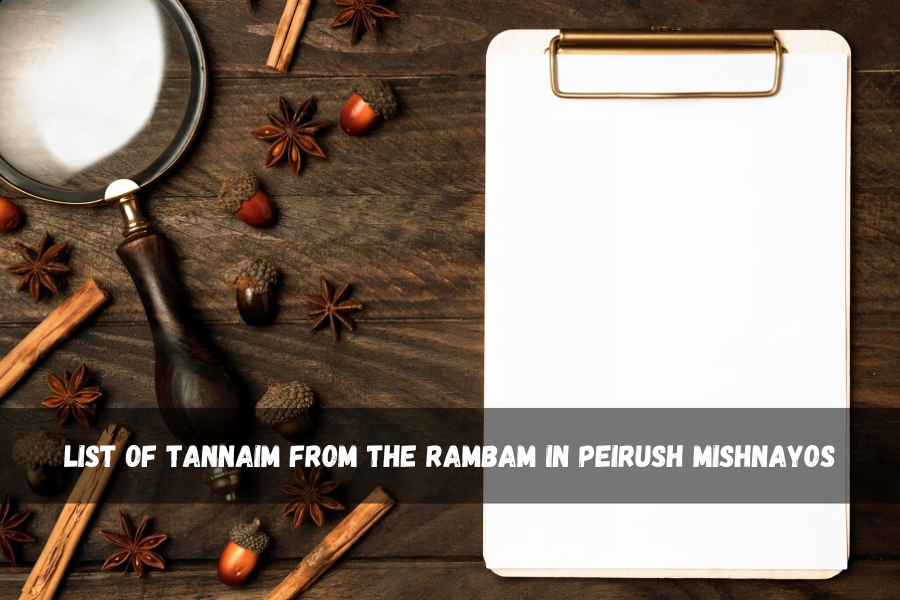Introduction
Maimonides, also known as the Rambam, stands as a monumental figure in Jewish history, whose writings have profoundly shaped Jewish law, philosophy, and tradition. Among his influential works is his Peirush Mishnayos (Commentary on the Mishnah), where he presents an essential list of Tannaim—the early sages of the Mishnah. These Tannaim played a critical role in the development and preservation of the Oral Law. In his commentary, the Rambam meticulously explains their contributions and significance. This article will explore the Rambam’s list of Tannaim, shedding light on their roles, impact, and lasting legacy within Jewish tradition.
Who Were the Tannaim?
The Tannaim, a group of Jewish sages from the first two centuries CE, were instrumental in shaping Jewish law, which was later compiled into the Mishnah. Their teachings, discussions, and legal decisions laid the foundation for much of what we recognize today as Rabbinic Judaism. Maimonides (Rambam), in his commentary on the Mishnah, frequently refers to these sages, drawing on their wisdom to clarify the legal and philosophical principles embedded in the text. Their contributions remain central to understanding the development of Jewish law and tradition.
List of Tannaim Referenced by Rambam
Here is a succinct overview of prominent Tannaim that the Rambam emphasizes in his Peirush Mishnayos, along with brief summaries of their key contributions to Jewish law and tradition. These sages played a vital role in shaping the legal and philosophical discussions that continue to influence Jewish thought today.
Rabbi Akiva
Rabbi Akiva is arguably one of the most renowned Tannaim, with an enduring legacy in Jewish history. He is best known for organizing and structuring Jewish oral law, which significantly contributed to the formation of the Mishnah. His profound impact on Jewish thought is unmatched, and the Rambam often draws upon his wisdom and teachings in his works.
Rabbi Meir
Rabbi Meir, one of Rabbi Akiva’s foremost students, is celebrated for his exceptional intellect and deep understanding of the Torah. His ability to simplify and clarify intricate legal matters earned him great respect. The Rambam frequently references Rabbi Meir’s insights and rulings, showcasing his significant contributions to Jewish legal tradition.
Rabbi Shimon bar Yochai
Rabbi Shimon bar Yochai, a mystic and devoted student of Rabbi Akiva, is traditionally credited with authoring the Zohar, the cornerstone of Jewish mysticism. Known for his deep spiritual insight, Rabbi Shimon is frequently referenced by the Rambam, who highlights his distinct views on Jewish law and spirituality. His contributions continue to resonate within both legal and mystical aspects of Jewish tradition.
Hillel the Elder
Hillel, revered for his patience and kindness, was one of the earliest and most respected Tannaim. His teachings consistently promoted humility and compassion, values that left a lasting impression on Jewish thought. The Rambam often references Hillel’s wisdom, particularly when discussing ethical behavior, reflecting the deep admiration he held for these guiding principles.
Shammai
Shammai, often seen as the counterpart to Hillel, was recognized for his more stringent interpretation of Jewish law. The Rambam frequently contrasts the approaches of Hillel and Shammai, using their differing views to highlight the richness of debate among the Tannaim and the critical role such discussions played in shaping legal decisions. This contrast underscores the diversity of thought that was essential to the development of Jewish law.
Rabbi Yehuda HaNasi
As the compiler of the Mishnah, Rabbi Yehuda HaNasi was crucial in preserving Jewish oral traditions. His efforts laid the groundwork for the Rambam’s commentary, which is why he is among the most frequently cited Tannaim in the Peirush Mishnayos. His significant contributions have had a lasting impact on Jewish law and scholarship.
Rabbi Eliezer ben Hurcanus
Rabbi Eliezer, a student of Rabbi Yochanan ben Zakkai, was renowned for his unwavering commitment to tradition and his steadfast adherence to the principles of the Torah. The Rambam frequently references Rabbi Eliezer to exemplify the importance of resilience and consistency, particularly in times of change. His teachings emphasize the value of remaining true to one’s beliefs in the face of evolving circumstances.
Rabbi Tarfon
Rabbi Tarfon, a contemporary of Rabbi Akiva, is celebrated for his humility and respect toward his peers. The Rambam often cites Rabbi Tarfon’s legal rulings to highlight the importance of balancing personal modesty with scholarly authority. His approach serves as a model for how humility can coexist with intellectual rigor in the study of Jewish law.
Rabban Gamliel
Rabban Gamliel, a prominent member of the esteemed Gamliel family, held the position of Nasi (leader) of the Sanhedrin and played a crucial role in shaping the Jewish legal system after the destruction of the Second Temple. The Rambam holds Rabban Gamliel’s leadership in high regard and frequently references his rulings, acknowledging his significant contributions to Jewish law during a pivotal era in history.
Rabbi Yochanan ben Zakkai
Rabbi Yochanan ben Zakkai, a distinguished sage, founded the Yavneh academy following the destruction of the Second Temple, playing a vital role in preserving Judaism. The Rambam values his vision and often cites his rulings, recognizing him as a pivotal figure in the continuity of Jewish tradition during a critical time in history.
Importance of the List of Tannaim from the Rambam in Peirush Mishnayos
Maimonides’ List of Tannaim in his Peirush Mishnayos was originally composed in Arabic before being translated into Hebrew. This essential work delves into the intricate legal and ethical discussions found in the Mishnah, offering valuable explanations and insights. The Rambam’s commentary is notable for its unique approach to elucidating the Mishnah, often summarizing extensive debates and presenting them in a clear, logical format. One of its key strengths lies in the Rambam’s thorough listing and analysis of the Tannaim, which enriches our understanding of these influential scholars and their contributions.
Written during Maimonides’ younger years, this commentary serves as a precursor to his more extensive works, such as the Mishneh Torah. Despite its earlier origins, it remains highly regarded for its clarity and intellectual depth. Within his commentary, the Rambam not only addresses the legal dimensions of the Mishnah but also provides historical and biographical context about the Tannaim who significantly shaped these laws.
Key Contributions of the Tannaim
Codification of Oral Law
The codification of the Oral Law into the Mishnah stands as one of the Tannaim’s most crucial contributions. The Rambam highlights that, without the dedication of the Tannaim, the Oral Law could have been at risk of being forgotten, particularly after the destruction of the Second Temple and the ensuing Roman persecution of the Jewish people.
The Mishnah acts as a vital link between the written Torah and subsequent legal interpretations, safeguarding traditions that are essential for maintaining Jewish practice throughout history.
Development of Halakhic Discourse
The Tannaim participated in thorough discussions and analyses of Jewish law, creating a structured framework for studying and interpreting Halakha. The Rambam notes that these debates established a foundation for future scholars, who would expand upon the principles laid out in his Peirush Mishnayos.
This vibrant discourse fostered a dynamic and adaptable legal system, one that could evolve with changing circumstances while staying true to its ancient traditions.
Creation of Educational Institutions
Many figures from the List of Tannaim in the Peirush Mishnayos, including Rabban Yohanan ben Zakkai and Rabbi Akiva, played a crucial role in founding learning academies dedicated to the study of the Oral Law. The Rambam emphasizes that these institutions were vital for preserving Jewish law and practice, particularly following the destruction of the Temple.
Academies in places like Yavneh, Tiberias, and Lod emerged as prominent centers of scholarship, drawing in scholars from all over the Jewish world and fostering a rich intellectual community.
Comparison of Rambam’s List with Other Sources
Tannaim in the Babylonian Talmud vs. Peirush Mishnayos
Rambam’s List of Tannaim in Peirush HaMishnayos aligns with the Tannaim referenced in the Babylonian Talmud; however, there are notable differences in emphasis. While the Talmud focuses on the legal disputes among the Tannaim, Rambam’s commentary highlights their teachings as they relate to his own legal philosophy. This approach allows him to integrate their lessons into his broader interpretation of Jewish law.
Differences in Attribution of Teachings
At times, Rambam attributes teachings to Tannaim that are not identified in other sources. These discrepancies may arise from his reliance on different manuscript traditions or his unique interpretations of Talmudic discussions. Such variations illustrate the intricacies of rabbinic tradition and the challenges associated with accurately attributing teachings to specific Tannaim.
Rambam’s Unique Perspectives on Tannaim
Maimonides’ perspective on the Tannaim reveals his philosophical and legal principles. He often emphasizes the logical and ethical dimensions of their teachings, aligning them with his own views on Jewish law and morality. This unique approach transforms Peirush HaMishnayos into more than just a practical legal commentary; it also provides valuable insight into Maimonides’ comprehensive understanding of Judaism.
The Legacy of the Tannaim in Jewish Thought
The impact of the Tannaim reaches well beyond their own eras. Their teachings are still actively studied in Jewish seminaries across the globe. Rambam’s commentary on their works plays a crucial role in keeping their wisdom available for future generations. By carefully recording their perspectives, Maimonides not only preserved the details of their legal teachings but also captured the essence of their philosophies.
Conclusion
Maimonides’ List of Tannaim in Peirush Mishnayos serves as a vital resource for understanding the foundational figures of Jewish law and tradition. By meticulously detailing the contributions of these early sages, the Rambam not only preserves their teachings but also emphasizes their lasting significance in shaping Rabbinic Judaism. The Tannaim’s commitment to codifying oral traditions, fostering educational institutions, and engaging in halakhic discourse has ensured that their wisdom continues to resonate within Jewish thought today. Through Maimonides’ insightful commentary, we gain a deeper appreciation for the Tannaim’s roles as custodians of Jewish law and philosophy, underscoring their enduring legacy that continues to guide and inspire contemporary Jewish practice.
FAQs
1. Who were the Tannaim?
The Tannaim were a group of Jewish sages from the first two centuries CE who played a crucial role in shaping Jewish law and tradition. Their teachings and legal decisions laid the foundation for the Mishnah, the central text of Rabbinic Judaism.
2. What is the Peirush Mishnayos?
The Peirush Mishnayos, written by Maimonides, is a commentary on the Mishnah that elucidates its legal and philosophical principles. It includes a comprehensive list of Tannaim, highlighting their contributions and significance within Jewish law and tradition.
3. Why is Rabbi Akiva significant in the context of the Tannaim?
Rabbi Akiva is one of the most renowned Tannaim, known for organizing Jewish oral law and significantly contributing to the Mishnah’s formation. His teachings continue to influence Jewish thought and law.
4. How does Maimonides’ list of Tannaim differ from those found in other texts?
While Maimonides’ List of Tannaim aligns with references in the Babylonian Talmud, it emphasizes their teachings as they relate to his own legal philosophy. Additionally, he sometimes attributes teachings to Tannaim not identified in other sources, reflecting variations in rabbinic tradition.
5. What is the importance of the Tannaim in contemporary Jewish study?
The teachings of the Tannaim are actively studied in Jewish seminaries worldwide, and their contributions continue to shape modern Jewish thought and practice. Maimonides’ commentary plays a crucial role in keeping their wisdom accessible to future generations.
Stay informed with the news and updates on LET MAGAZINE!



